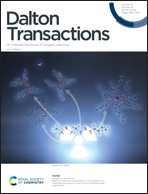Designing one-compartment H2O2 fuel cell using electroactive phenalenyl-based [Fe2(hnmh-PLY)3] complex as the cathode material†
Abstract
The sustainable chemical energy of H2O2 as a fuel and an oxidant in an advantageous single-compartment fuel cell design can be converted into electric energy, which requires molecular engineering to design suitable cathodes for lowering the high overpotential associated with H2O2 reduction. The present work covers the synthesis and structural characterization of a novel cathode material, [FeIII2(hnmh-PLY)3] complex, 1, designed from a PLY-derived Schiff base ligand (E)-9-(2-((2-hydroxynaphthalen-1-yl)methylene)hydrazineyl)-1H-phenalen-1-one, hnmh-PLYH2. Complex 1, when coated on the surface of a glassy carbon electrode (GC-1) significantly catalyzed the reduction of H2O2 in an acidic medium. Therefore, a complex 1 modified glassy carbon electrode was employed in a one-compartment H2O2 fuel cell operated in 0.1 M HCl with Ni foam as the corresponding anode to produce a high open circuit potential (OCP) of 0.65 V and a peak power density (PPD) of 2.84 mW cm−2. CV studies of complex 1 revealed the crucial participation of two Fe(III) centers for initiating H2O2 reduction, and the role of coordinated redox-active PLY units is also highlighted. In the solid state, the π-conjugated network of coordinating (hnmh-PLY) ligands in complex 1 has manifested interesting face-to-face π–π stacking interactions, which have helped the reduction of the complex and facilitated the overall catalytic performance.
![Graphical abstract: Designing one-compartment H2O2 fuel cell using electroactive phenalenyl-based [Fe2(hnmh-PLY)3] complex as the cathode material](/en/Image/Get?imageInfo.ImageType=GA&imageInfo.ImageIdentifier.ManuscriptID=D4DT00134F&imageInfo.ImageIdentifier.Year=2024)
- This article is part of the themed collection: Celebrating International Women’s Day 2025: Women in Inorganic Chemistry


 Please wait while we load your content...
Please wait while we load your content...